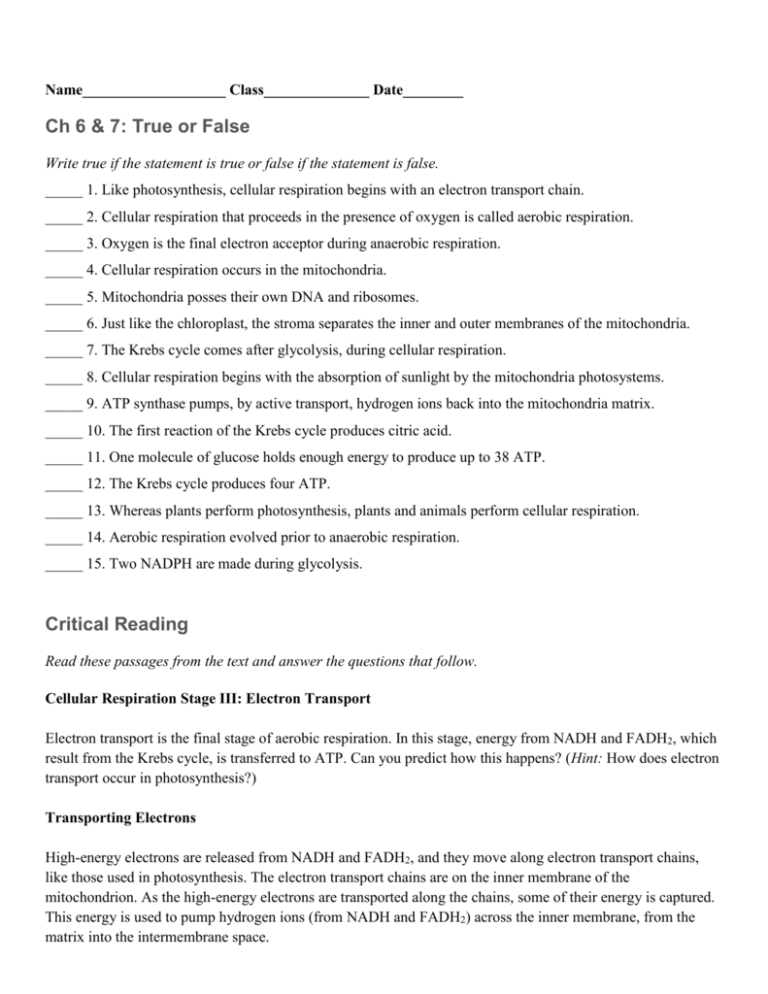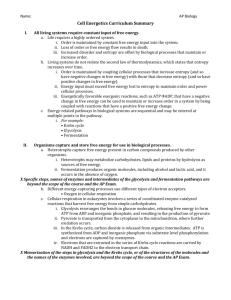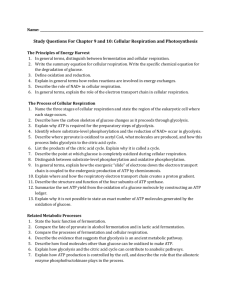Cellular Respiration Stage III: Electron Transport
advertisement

Name___________________ Class______________ Date________ Ch 6 & 7: True or False Write true if the statement is true or false if the statement is false. _____ 1. Like photosynthesis, cellular respiration begins with an electron transport chain. _____ 2. Cellular respiration that proceeds in the presence of oxygen is called aerobic respiration. _____ 3. Oxygen is the final electron acceptor during anaerobic respiration. _____ 4. Cellular respiration occurs in the mitochondria. _____ 5. Mitochondria posses their own DNA and ribosomes. _____ 6. Just like the chloroplast, the stroma separates the inner and outer membranes of the mitochondria. _____ 7. The Krebs cycle comes after glycolysis, during cellular respiration. _____ 8. Cellular respiration begins with the absorption of sunlight by the mitochondria photosystems. _____ 9. ATP synthase pumps, by active transport, hydrogen ions back into the mitochondria matrix. _____ 10. The first reaction of the Krebs cycle produces citric acid. _____ 11. One molecule of glucose holds enough energy to produce up to 38 ATP. _____ 12. The Krebs cycle produces four ATP. _____ 13. Whereas plants perform photosynthesis, plants and animals perform cellular respiration. _____ 14. Aerobic respiration evolved prior to anaerobic respiration. _____ 15. Two NADPH are made during glycolysis. Critical Reading Read these passages from the text and answer the questions that follow. Cellular Respiration Stage III: Electron Transport Electron transport is the final stage of aerobic respiration. In this stage, energy from NADH and FADH2, which result from the Krebs cycle, is transferred to ATP. Can you predict how this happens? (Hint: How does electron transport occur in photosynthesis?) Transporting Electrons High-energy electrons are released from NADH and FADH2, and they move along electron transport chains, like those used in photosynthesis. The electron transport chains are on the inner membrane of the mitochondrion. As the high-energy electrons are transported along the chains, some of their energy is captured. This energy is used to pump hydrogen ions (from NADH and FADH2) across the inner membrane, from the matrix into the intermembrane space. Making ATP The pumping of hydrogen ions across the inner membrane creates a greater concentration of the ions in the intermembrane space than in the matrix. This chemiosmotic gradient causes the ions to flow back across the membrane into the matrix, where their concentration is lower. ATP synthase acts as a channel protein, helping the hydrogen ions cross the membrane. It also acts as an enzyme, forming ATP from ADP and inorganic phosphate. After passing through the electron-transport chain, the “spent” electrons combine with oxygen to form water. This is why oxygen is needed; in the absence of oxygen, this process cannot occur. How Much ATP? You have seen how the three stages of aerobic respiration use the energy in glucose to make ATP. How much ATP is produced in all three stages? Glycolysis produces 2 ATP molecules, and the Krebs cycle produces 2 more. Electron transport begins with several molecules of NADH and FADH2 from the Krebs cycle and transfers their energy into as many as 34 more ATP molecules. All told, then, up to 38 molecules of ATP can be produced from just one molecule of glucose in the process of aerobic respiration. Questions 1. In photosynthesis, electron transport comes at the beginning of the process. Where does electron transport occur during cellular respiration? 2. What is the role of the electron transport chain in cellular respiration? 3. Why is the role of oxygen in cellular respiration? 4. Describe ATP synthase and its role. 5. Summarize how up to 38 molecules of ATP are produced for each glucose molecule. Multiple Choice Circle the letter of the correct choice. 1. Glycolysis a. uses 2 ATPs and makes 2 ATPs, 2 NADHs, and 2 pyruvates. b. uses 2 ATPs and makes 4 ATPs, 2 NADHs, and 2 pyruvates. c. uses 4 ATPs and makes 2 ATPs, 2 NADHs, and 2 pyruvates. d. uses 2 ATPs and makes 4 ATPs, 4 NADHs, and 2 pyruvates. 2. Cellular respiration in the presence of oxygen is called a. anaerobic respiration. b. glycolysis. c. aerobic respiration. d. oxygen respiration. 3. The correct order of stages of cellular respiration is a. glycolysis - the Calvin cycle - electron transport. b. the light reactions - glycolysis - the Krebs cycle. c. glycolysis - the Krebs cycle - electron transport. d. electron transport - glycolysis - the Krebs cycle. 4. Where are the electron transport chains of cellular respiration located? a. in the inner membrane of the mitochondrion b. in the matrix of the mitochondrion c. in the intermembrane space of the mitochondrion d. in the outer membrane of the mitochondrion 5. The final electron acceptor at the end of cellular respiration is a. hydrogen. b. oxygen. c. water. d. ATP synthase. 6. The chemical formula of cellular respiration is a. b. c. d. 6CO2 + 6H2O → C6H12O6 + 6O2. C6H12O6 + O2 → CO2 + H2O. CO2 + H2O → C6H12O6 + O2. C6H12O6 + 6O2 → 6CO2 + 6H2O. 7. The chemiosmotic gradient of cellular respiration is an a. ion gradient made by the pumping of hydrogen ions across the inner membrane using the energy of electrons as they are transported down the electron transport chain. b. ion gradient made by the pumping of hydrogen ions across the outer membrane using the energy of electrons as they are transported down the electron transport chain. c. ion gradient made by the pumping of oxygen ions across the inner membrane using the energy of electrons as they are transported down the electron transport chain. d. ion gradient made by the diffusion of hydrogen ions across the inner membrane using the energy of electrons as they are transported down the electron transport chain. 8. In the presence of oxygen, one glucose molecule has the energy to make up to a. 4 FADH2. b. 12 NADH. c. 38 ATP. d. all of the above Vocabulary I Match the vocabulary word with the proper definition. Definitions _____ 1. channel protein and enzyme that makes ATP _____ 2. also known as the Krebs cycle _____ 3. energy-carrying compound produced during the Krebs cycle _____ 4. end product of glycolysis _____ 5. cellular respiration in the absence of oxygen _____ 6. energy-carrying compound involved in stage I and stage II of cellular respiration _____ 7. a greater concentration of hydrogen ions in the intermembrane space than in the mitochondrial matrix _____ 8. stage II of cellular respiration _____ 9. “folds” created by the mitochondria inner membrane _____ 10. glucose splitting _____ 11. involved in stage III of cellular respiration _____ 12. cellular respiration in the presence of oxygen Terms a. aerobic respiration b. anaerobic respiration c. ATP synthase d. chemiosmotic gradient e. citric acid cycle f. cristae g. electron transport chain h. FADH2 i. glycolysis j. Krebs cycle k. NADH l. pyruvate Vocabulary II Fill in the blank with the appropriate term. 1. The reactions of cellular respiration can be grouped into three stages: ____________, the ____________ cycle, and electron transport. 2. Cellular respiration in the absence of oxygen is called ____________ respiration. 3. The last two stages of cellular respiration occur in the ____________. 4. Most of the ATP is produced in stage ____________ of cellular respiration. 5. ____________ is the final electron acceptor at the end of the electron transport chain, when water is formed. 6. During glycolysis, enzymes split a molecule of glucose into two molecules of ____________. 7. ____________ releases the energy in glucose to make ATP. 8. During the Krebs cycle, energy is captured in molecules of ____________, ____________, and FADH2. 9. ____________ is the molecule that enters the Krebs cycle. 10. During glycolysis, ____________ molecules of ATP are used, and ____________ molecules of ATP are made. 11. ____________ is the enzyme that produces ATP during the final stage of cellular respiration. 12. In all three stages of aerobic respiration, up to ____________ molecules of ATP may be produced from a single molecule of glucose. Critical Writing Thoroughly answer the question below. Use appropriate academic vocabulary and clear and complete sentences. Discuss why photosynthesis and cellular respiration can be described as a cycle.








